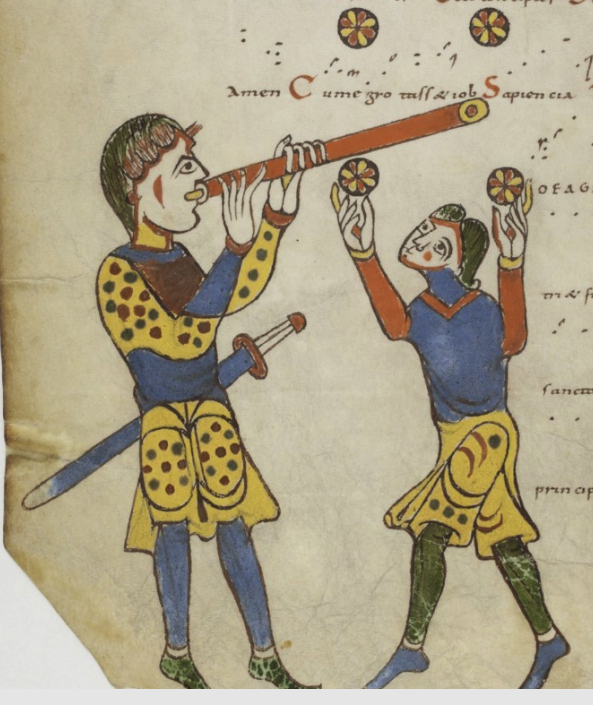Do These Heads Tell Tales?
Some of the Voynich plants have a more naturalistic feel to them, including “viola” and the “water lily”, and some have stylistic differences and less obvious botanical structures that may be mnemonic, or representative of something more than (or something different from) a botanical illustration.
 Plant 51v strikes me as more stylized than many of the other plants. The leaves look like beetles, the flowers have alternating colors that remind me of pinwheels (I call them spinnerheads), the roots look like a pair of medieval hose with legs crossed, including the long pointed toes that were all the rage.
Plant 51v strikes me as more stylized than many of the other plants. The leaves look like beetles, the flowers have alternating colors that remind me of pinwheels (I call them spinnerheads), the roots look like a pair of medieval hose with legs crossed, including the long pointed toes that were all the rage.
Taken as a whole, the composition has a lively dancing feel to it, but I held off writing about it because I didn’t know how to convey this impression in words.
And then I stumbled upon an 11th-century image that conveys the same feeling I get from looking at the VMS plant drawing and it has the added bonus of… alternating flower-like “petals” in the same basic colors as the VMS.
Troubadours and Jongleurs
Medieval peasants and gentry loved entertainment and many of the nobility had live-in musicians, magicians, jugglers, and poets. There were also itinerant storytellers and colorful entertainers who traveled the country in wagons, a tradition that continues today in the modern circus.
This fabulous image is startling in its tropical brightness at a time when natural earth pigments could be quite pale and subdued. The colors fit well with the theme, commemorating those who brighten our day with music and sport. Other folios with musical notation are created in a similar style.
On the left, the musician wears a jaunty two-toned shirt with red collar and cuffs, and plays a double-reed flute (a forerunner to our oboe). Each cheek sports a clown-like spot of red. His fingers are unusually long and gracefully curved, reminiscent of Balinese dancers and elegantly long Buddha fingers. In fact, there’s a gourd named “Buddha’s hand” that looks just like this. The eyes resemble those in Persian paintings that feature almond shapes and long curving eyebrows. To his right is a person of small stature. Dwarves and midgets had limited opportunities for employment in the middle ages, so those with special talents often ended up as entertainers in royal courts. It is said that a gifted poet whose name may be featured on the Bayeau tapestry may have been a dwarf. Like the musician, the juggler has stage-makeup cheeks, very long, eastern-style fingers, and two objects that may be balls or some kind of round object that he is deftly spinning on his fingertips. There is a second folio that repeats this theme and shows the balls high in the air.
To his right is a person of small stature. Dwarves and midgets had limited opportunities for employment in the middle ages, so those with special talents often ended up as entertainers in royal courts. It is said that a gifted poet whose name may be featured on the Bayeau tapestry may have been a dwarf. Like the musician, the juggler has stage-makeup cheeks, very long, eastern-style fingers, and two objects that may be balls or some kind of round object that he is deftly spinning on his fingertips. There is a second folio that repeats this theme and shows the balls high in the air.

Musician and juggle in the Tropaire-Prosaire à l’usage d’Auch, c. 990 to c. 1010, Abbey Saint-Martial de Limoges
It’s tempting to think the manuscript was created by someone from the southern or eastern Mediterranean (or someone influenced by eastern art), but it’s illustrated by the painter of the lectionary of the library of the Abbey of Saint-Martial in Limoges, France, and much of the painter’s work shows Roman influence rather than eastern. The same painter is said to have worked on a large number of manuscripts.
Even the images with Roman themes have very long pointed fingers, mixed with fingers of normal proportions with rounded ends. The large portions of blue pigment in the jongleur images are absent in many of the other drawings, giving these pages a special look and feel.
Summary
I don’t have time to look into the Tropaire-Prosaire à l’usage d’Auch in more depth, but I thought Voynich researchers might enjoy the unique style of the image, and the juggling balls that resemble the VMS flowers. I don’t know if the pattern on the balls is meant to be decorative or to simulate the motion of spinning balls, but it’s one of the few examples of alternating orange and light “petals” that I’ve seen so far.
Getting back to the VMS plant, the shape of the plant very much reminds me of a dancer. Whether this is accidental or intentional, I can’t be sure, but if it is intended to be botanical, perhaps the unusual pose has some stylistic or mnemonic significance to the plant.
J.K. Petersen
© Copyright 2017 J.K. Petersen, All Rights Reserved
